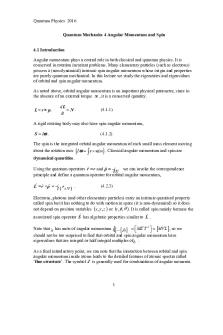Angular Momentum - lecture 11 PDF

| Title | Angular Momentum - lecture 11 |
|---|---|
| Course | Biomechanics |
| Institution | The University of Western Ontario |
| Pages | 8 |
| File Size | 403.5 KB |
| File Type | |
| Total Downloads | 104 |
| Total Views | 147 |
Summary
lecture 11...
Description
Angular Momentum Angular momentum is the rotational inertia of an object multiplied by its angular velocity
Similar to linear momentum, this is the quantity of rotational motion in the object
Angular momentum is a measure of how hard it will be to stop the object rotating
Remember the radius of gyration and how we use it to find the rotational inertia
So angular momentum is also,
But how does angular momentum relate to torque?
But
so if we multiply by I, we get
so that,
And taking delta t to be infinitesimally small,
Therefore, torque is the time rate of change of angular momentum
Just like a torque, angular momentum is a vector
1. 2. 3. 4.
Magnitude is rotational inertia times angular speed Direction is the axis of rotation Point of application is the axis of rotation Line of action is along the axis of rotation
Angular Impulse Lets go back to one of the equations we derived:
And rearrange it a bit:
The quantity of torque times time is called angular impulse One last rearrangement
So if you are rotating with angular momentum L1 and an angular impulse is applied to you for an amount of time delta t, then you end up with new angular momentum L2.
Angular Momentum To create angular momentum in an object, such as this tennis racket, a torque must be applied. In this case at the shoulder Angular momentum of racket and arm produced by shoulder muscle torque
Once airborne you angular momentum is constant since you have no reaction forces with which to create a torque about your center of mass Angular momentum of the body produced by the reaction force of the horse x dperpedicular to vaulter’s push of
Linear and Angular Momentum An object can have both linear and angular momentum at the same time
Creating Angular Momentum
Stability of Angular Momentum When an object is rotating about an axis, with angular momentum, it has gyroscopic stability What this means is that it requires a torque to change the direction of the axis of rotation Angular momentum vector will always point in the same direction when no external torques
Conservation of Angular Momentum It is a diver’s control to change their rotational inertia, I, by changing the orientation of their body segments Remember, I is large when mass is far from the axis of rotation I is small when we are tucked in tight and mass is close to the axis of rotation This way the diver controls the angular speed. Faster in tuck, slower when laid out.
Conservation of Angular Momentum The whole time the angular momentum is constant
Since angular momentum is a vector, then it can be broken up into components Each component is a rotation about an axis...
Similar Free PDFs

Angular Momentum - lecture 11
- 8 Pages

Lab Report 5 -Angular momentum
- 6 Pages

Angular JS
- 10 Pages

Angular 10
- 2 Pages

11 - Lecture notes 11
- 14 Pages

Linear and Angular Kinematics
- 2 Pages

Materi MOMENTUM
- 6 Pages

Angular Motions - Biomechanics
- 2 Pages

Lecture EE333 - lecture 11
- 21 Pages

Lecture 11
- 2 Pages
Popular Institutions
- Tinajero National High School - Annex
- Politeknik Caltex Riau
- Yokohama City University
- SGT University
- University of Al-Qadisiyah
- Divine Word College of Vigan
- Techniek College Rotterdam
- Universidade de Santiago
- Universiti Teknologi MARA Cawangan Johor Kampus Pasir Gudang
- Poltekkes Kemenkes Yogyakarta
- Baguio City National High School
- Colegio san marcos
- preparatoria uno
- Centro de Bachillerato Tecnológico Industrial y de Servicios No. 107
- Dalian Maritime University
- Quang Trung Secondary School
- Colegio Tecnológico en Informática
- Corporación Regional de Educación Superior
- Grupo CEDVA
- Dar Al Uloom University
- Centro de Estudios Preuniversitarios de la Universidad Nacional de Ingeniería
- 上智大学
- Aakash International School, Nuna Majara
- San Felipe Neri Catholic School
- Kang Chiao International School - New Taipei City
- Misamis Occidental National High School
- Institución Educativa Escuela Normal Juan Ladrilleros
- Kolehiyo ng Pantukan
- Batanes State College
- Instituto Continental
- Sekolah Menengah Kejuruan Kesehatan Kaltara (Tarakan)
- Colegio de La Inmaculada Concepcion - Cebu





